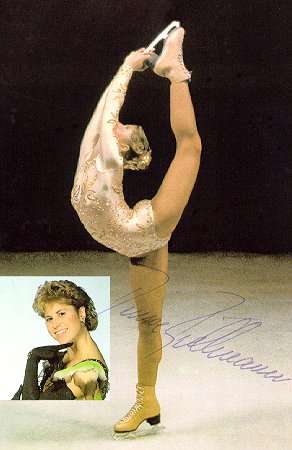When American figure skater Evan Lysacek won the gold medal at the 2010 Olympics, he was the only man on the podium who had not attempted a quadruple jump in either of his two skating programs. The silver medalist, 2006 Olympic Champion Evgeni Plushenko of Russia, was quick to point out that “a quad is a quad. If an Olympic champion doesn’t do a quad, well I don’t know… Now it’s not men’s figure skating, it’s dancing.” Plushenko’s website later proclaimed (though the claim was soon redacted) that his superior performance had earned him a “platinum” medal. Figure skaters and others who heard his comment understood this wasn’t just sour grapes; by questioning Lysacek’s jumping ability, Plushenko was also questioning his manhood.
As Daniel, a former singles and pairs skater, knows from personal experience, when you look below the surface of figure skating, a coded gendering of the sport emerges. Figure skating has both athletic and artistic components, and traditionally these have been apportioned to men and women, respectively. Men are expected to be able to land enormous jumps. Women, on the other hand, are more likely to grab one of their feet and pull it up behind their heads, sometimes while spinning fast enough to set off a nose-bleed, as Mirai Nagasu did in Vancouver. Women’s programs also emphasize a great deal of emotion when they skate, while men are expected to display their athletic strength and power.
This is not to say that women are not expected to jump or that men can be soulless automata, but there are lower expectations for each in the other gender’s territory. A male skater who doesn’t emote passionately can be forgiven if he has a fantastic triple axel, and a woman can even win the Olympics with jumps that aren’t fully rotated. Artistry and flexibility are where women are expected to excel, while boys strive to jump higher and rotate more. To this day, only one woman (Japan’s Miki Ando) has landed a clean quadruple jump in competition, while it has become a mainstay of men’s event. This video shows Ando’s jump, at a 2002 competition:
In the aftermath of his silver platinum silver medal finish in Vancouver, Plushenko questioned the qualifications of Evan Lysacek to win gold without a quad. Aside from being poor sportsmanship, his approach highlighted the deep association of jumps with male figure skating. Though, in the women’s event, Mao Asada completed the technically difficult triple axel on three separate occasions, no fuss was made over her second-place finish behind the ethereal Kim Yu-Na. Kim has strong jumps, to be sure, but what sets her apart from her competitors is that she skates in a way that is graceful, balletic and undeniably feminine.
Ironically, one of the most promising things about a young Evgeni Plushenko when he arrived on the international skating scene in 1997 was his blending of artistry and athleticism. His style was avant-garde and overwrought, and his jumps were magnificent; he had, in skating parlance,”the whole package.” It might seem excessive to map gender onto his performances, but he is famous for being one of the only men to perform the Biellmann spin, in which the skater grabs the blade of one skate and pulls it up behind the top of his or her head.
This was a clear and unabashed case of gender-bending, as the spin had previously been the province of women. The figure skating world, after being sufficiently impressed by the flexibility of his hips, shrugged and moved on. No one thought any less of him for doing a “girly” spin.
Compare this to the skating world’s reaction to two-time Olympic gold medalist Katarina Witt, who was often said to skate “like a man.” Witt had big jumps (and big thighs to go with them), and skated to the soundtracks of epic movies, a practice that was usually reserved for men, while other women tended to skate to classical ballet suites. Witt’s artistic style was also not typical of women skaters: while her competitors demonstrated flowing, balletic arm movements to match their floaty chiffon skating dresses, Witt opted for stronger, cleaner arm movements and famously skated in leggings and a tunic in a program set to music from Robin Hood. She also skated with a stoic bearing that was similar to that of Canadian Elvis Stojko, who won the silver medal in Lillehammer in 1994.
Despite the popular perception of figure skating as a uniformly “girly” sport, there exists within the figure skating world a unique and nuanced code for constructing and understanding gender. In the figure skating world, as in the rest of our culture, that code changes over time, with different representations of masculinity and femininity being rewarded, marked down, or phased out entirely as the sport evolves. And as Plushenko’s comments about Lysacek demonstrated, figure skating’s coding of gender can be invoked by skaters trash-talking their rivals in subtle, but complicated, ways. As yet, Plushenko has made no comment on Lysacek’s upcoming appearance on “Dancing with the Stars,” but it’s not hard to imagine what he might have to say.
——————–
Chloe Angyal is a Contributor at Feministing.com, where she writes about gender in popular culture. She is also a failed figure skater. Daniel Eison is a former nationally-ranked pairs and singles skater who retired in 2005. He is not a failed feminist.
——————–
Gender differences in figure skating are also institutionalized in the form of costume requirements. Women are required to wear dresses, while men are not allowed to wear leggings or sleeveless outfits.
UPDATE: Reader Jeff says,
This isn’t true anymore; “this rule was repealed in 2004, allowing women to wear tights, trousers, or unitards” [1] ([1] http://www.frogsonice.com/skateweb/faq/rules.shtml)
Thanks for the correction!
Related posts: Johnny Weir and Canadian skating gets tough.










